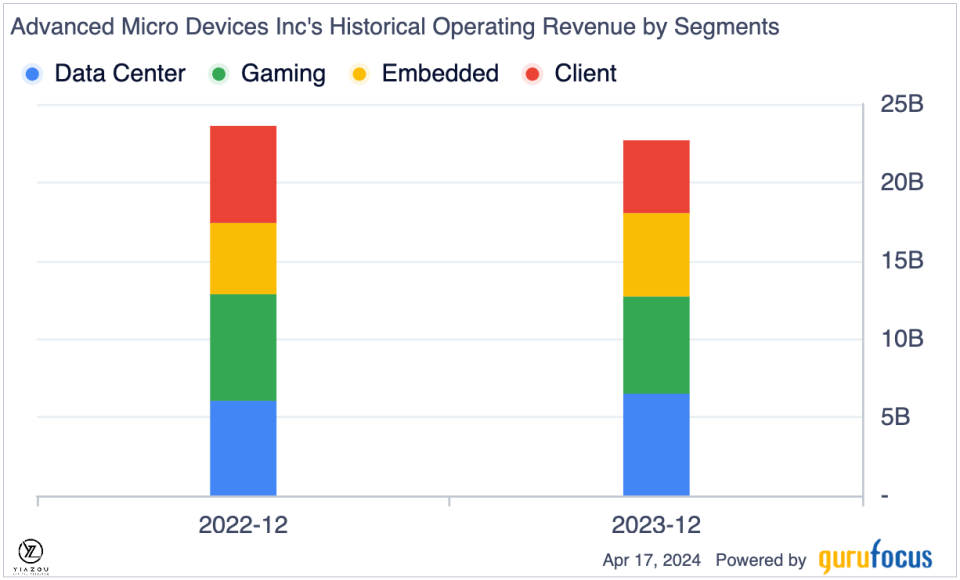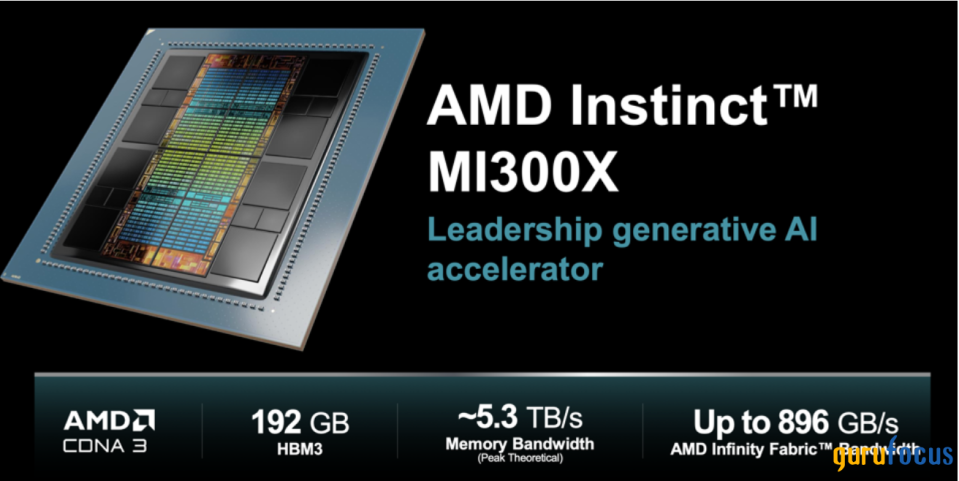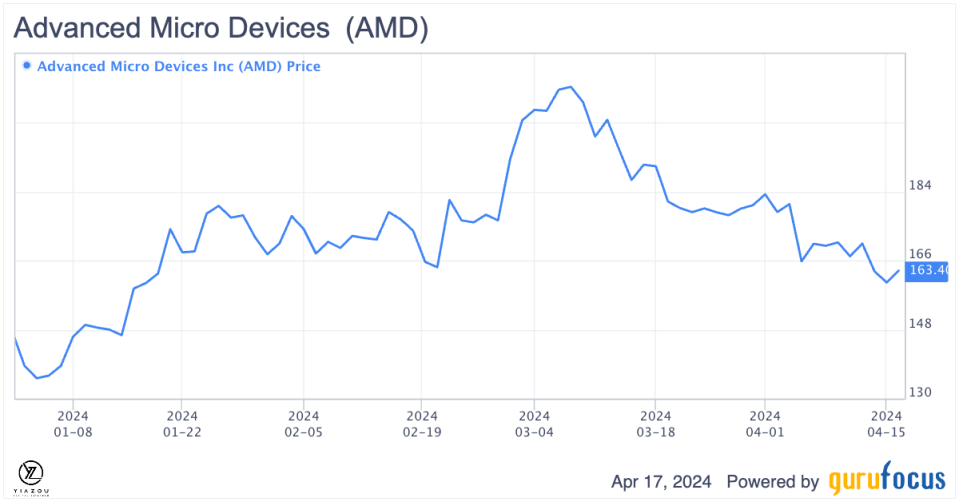AI Is Powering AMD's Future
Amidst the artificial intelligence revolution and increasing chip demand, Advanced Micro Devices Inc. (NASDAQ:AMD) has shown remarkable resilience and strategic growth. Despite a recent 20% pullback from its highs, indicating market consolidation, the stock remains robust, trading above critical averages and maintaining positive momentum.
This resilience is bolstered by AMD's strategic focus on expanding its footprint in the data center and AI chip markets, challenging industry leaders like Nvidia Corp. (NASDAQ:NVDA).
With key tech partnerships and an ambitious sales growth target for server GPUs, AMD is well-positioned to capitalize on the surging demand for AI and data center capabilities, signaling a promising outlook in the semiconductor space.
AMD Data by GuruFocus
AMD eyes data center growth and AI chip market, securing key tech partnerships
Amid the headwinds in China, AMD has given a bullish update on its AI chips and appears to be well-positioned to challenge Nvidia's dominance. Likewise, the company has set its sights on significant growth in the data center segment, where demand for powerful chips capable of handling massive data requirements for AI is rising.
The chip giant expects to generate $3.50 billion in server GPU sales in 2024, up from an initial target of $2 billion. The expected growth comes from the company's strategic partnerships with Microsoft (NASDAQ:MSFT), Oracle (NYSE:ORCL) and Meta Platforms (NASDAQ:META), which have already shown strong interest in its chips. The leading semiconductor company known for its CPUs and GPUs delivered a 10% increase in fourth-quarter revenue, reaching a high of $6.20 billion.
Additionally, the increase was largely fueled by record sales in the data center segment amid solid demand for the company's Instinct GPUs and EPYC CPUs. Data center revenue for the quarter was up 38% to $2.30 billion, underscoring the company's competitive edge in this critical and growing market.
AMD's stellar performance affirms its strategic positioning and long-term prospects because the semiconductor industry is focused on data centers and AI applications. According to the CEO Lisa Su, the strong demand positions the company for significant growth as artificial intelligence reshapes the computing market.
Moreover, robust revenue growth remains the catalyst behind the company's improved financial performance. Its net income in the fourth quarter increased by about 3,000% to $667 million from just $21 million in the same quarter last year. Net income growth was bolstered by the 38% growth in data center revenue as the company also managed its operational expenses, effectively coming in at $6.60 billion compared to $6 billion in the previous year.
Finally, profitability has improved significantly amid the AI frenzy that has triggered strong demand for the company's chips. Hence, AMD has bounced to profitability of 18 cents and 41 cents per share over the past two quarters, while gross margins improved to 47% from 43%, driven by robust revenue growth.

Strategic play to challenge Nvidia's dominance in the AI GPU market
AI is evolving at a breakneck pace, becoming an area that has turned into a battlefield for semiconductor magnates. And that's happening right in the niche of AI GPUs, meaning graphics processing units designed for the ever-more sophisticated and specialized purposes of AI.
The MI300X AI GPU is a major leap for AMD in its effort to seize market share that is currently held by Nvidia, especially in competition with the latter's H100 chip. The company's strategy is competitive pricing, technological innovation and a more intensified software ecosystem to be a very strong player.

Source: AMD
Breaking the price barrier
A key aspect of AMD's approach is its pricing strategy for the MI300X AI GPU. Widely anticipated to come in at under $40,000, it would present a more budget-friendly option than Nvidia's H100 chip.
It is, therefore, expected that this strategic pricing will really lower the barriers for companies and research institutions keen on delving into AI model development, where advanced AI computing can be accessible by a larger audience.
By undercutting Nvidia on price, AMD targets users that are looking for high-performance computing solutions, but not at a premium price point.
The new frontier in AI computing: Revolutionary architecture and enhanced software ecosystem
The very heart of the MI300X is potentially game-changing architecture, driving AMD's challenge to Nvidia with big upgrades over the H100.
The 192GB of HBM3 memory packed inside the MI300X suggests AMD is pushing into high-performance memory technology with faster data transfers; this is also key to supporting more powerful, bigger and increasingly sophisticated AI models.
That would underline MI300 as the fastest in reaching $1 billion in sales for a chipset and signal the lightning-fast market expectation on the product's adoption and readiness for a competitive alternative to Nvidia's offerings. This was reflected in the development very positively; it was an affirmation of the technological leadership of the product and the thrust in strategic marketing by AMD.
Now that the AI GPU supremacy battle is fought on more than hardware grounds, AMD has made a substantial update to its ROCm software suite. The move speaks directly to one of the largest barriers to changing GPU suppliers: the software ecosystem.
Nvidia's CUDA has been the dominant standard in GPU-accelerated computing, effectively checking the inflow for any competitor. By enhancing the capabilities of the ROCm ecosystem, AMD is really taking on not only the hardware domain of Nvidia, but also software dominance, making the migration or development of AI-based projects on AMD GPUs much more developer-friendly.
Finally, according to tech expert Markus Schaal, AMD is challenging Nvidia's stronghold in the AI GPU market with its MI300X, which outperforms Nvidia's A100 GPU by more than 100% in FP32 workloads, offering a compelling advantage for AI and HPC applications. The company has significantly improved its ROCm software stack for AI, achieving near-parity with industry needs, enhancing compatibility with major AI frameworks and securing notable endorsements from tech leaders.
The road ahead
The all-encompassing approach by AMD to face off with Nvidia in the AI GPU market underlines a large degree of ambitious planning and what may change in the industry with regard to landscaping.
By providing a competitively priced product of top-notch quality and including the critical aspect of software support, AMD places itself as a vendor to be reckoned with in front of the established dominance of Nvidia. To challenge the company's deep-rooted dominance, AMD must combine aggressive marketing and continuous innovation with unwavering support from the developer community.
The AI GPU market is dynamic, with technological advancements and developer preferences constantly evolving. Success for AMD lies wholly in the current momentum it is maintaining in innovation, market penetration and ecosystem development to take on Nvidia, not as a technical powerhouse, but as a solutions provider for every aspect of AI.
Takeaway
Amidst the AI boom and growing chip demand, AMD showcases resilience and strategic growth, even after a 20% pullback. Focused on expanding its presence in the data center and AI markets, AMD challenges leaders like Nvidia with key partnerships and ambitious sales targets.
Its strong market position, supported by robust stock fundamentals and technological innovations, signals AMD's readiness to capitalize on AI and data center demands. This approach outlines AMD's strategic vision to navigate market shifts and stake a claim in the competitive semiconductor landscape, highlighting a promising path forward in the AI-driven era.
This article first appeared on GuruFocus.

 Yahoo Finance
Yahoo Finance 
